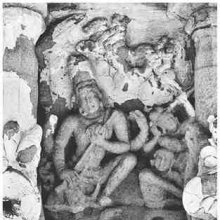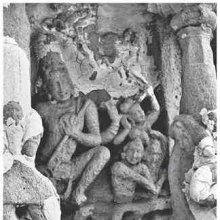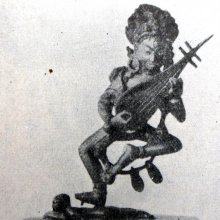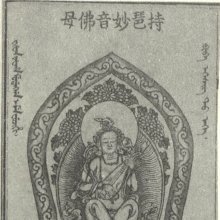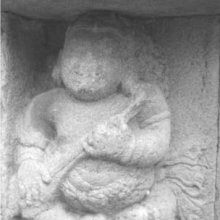Vina, Vinā, Vīṇā, Vīnā, Viña, Viṉā: 43 definitions
Introduction:
Vina means something in Buddhism, Pali, Hinduism, Sanskrit, Jainism, Prakrit, the history of ancient India, Marathi, Hindi, biology, Tamil. If you want to know the exact meaning, history, etymology or English translation of this term then check out the descriptions on this page. Add your comment or reference to a book if you want to contribute to this summary article.
Images (photo gallery)
(+33 more images available)
In Hinduism
Purana and Itihasa (epic history)
Source: Google Books: Cultural History from the Vāyu PurānaVīṇā (वीणा): a Musical Instrument.—The Ṛgveda mentions that Kṣoṇī or Viṇā was the musical instrument of the Maruts. The Jātakas shed more light on the construction, size and use of this instrument. It was very popular in the period of the Jātakas. In the Rāmāyaṇa it is a favourite instrument of the songsters, and similar is the case with the Mahābhārata. Kauṭilya also mentions it. The Vāyu-purāṇa refers to Vīṇā at four places mostly associating it with Śiva and the Kurus. Of Śiva it was a pet instrument.
Source: archive.org: Nilamata Purana: a cultural and literary studyVīṇā (वीणा) refers to a “musical instruments” that existed in ancient Kashmir (Kaśmīra) as mentioned in the Nīlamatapurāṇa.—The Nīlamata says that the land of Kaśmīra was thronged with ever-sportive and joyful people enjoying continuous festivities. Living amidst scenes of sylvan beauty they played, danced and sang to express their joys, to mitigate their pains, to please their gods and to appease their demons.
The Nīlamata refers to Vīṇā thrice only but if the references to Tantrī-vādya be taken as referring to vīṇā, it will yield that vīṇā was resorted to most by the musicians of Kaśmīra. The modern hundredstringed santoor of Kaśmīra is probably śatatantrīvīṇā or vāṇa referred to in the Taittirīya Saṃhitā.
Source: Cologne Digital Sanskrit Dictionaries: The Purana IndexVīṇā (वीणा).—Lute;1 presented by Sarasvatī to Skanda;2 in the garland of Umeśa, figures of apsaras with vīṇās3 in Pātālam4 in Rāma's abhiṣeka.5
- 1) Vāyu-purāṇa 54. 35.
- 2) Ib. 72. 46.
- 3) Matsya-purāṇa 260. 20.
- 4) Viṣṇu-purāṇa II. 5. 11.
- 5) Ib. IV. 4. 100.

The Purana (पुराण, purāṇas) refers to Sanskrit literature preserving ancient India’s vast cultural history, including historical legends, religious ceremonies, various arts and sciences. The eighteen mahapuranas total over 400,000 shlokas (metrical couplets) and date to at least several centuries BCE.
Shilpashastra (iconography)
Source: Wisdom Library: Śilpa-śāstraVīnā (वीना, “lute”):—In Hindu iconology (śilpaśāstra), this symbol represents mastery of skills (in performing arts). The sound of the Vīnā represents creativity, which is the power of consciousness to express itself. It is also one of the items Īśāṇa is displayed carrying, who is a Vedic deity and represents the embodiment of all learning.
Source: Google Books: Elements of Hindu iconographyVīṇā (वीणा).—It consists of a long hollow semi-cylidrical body with a number of keys on its sides. From each of these keys proceeds a string ofr wire which is stretched over the long body of the instrument and tied at the lower end. At this lower end is a square sounding box, and to the upper end a hollow gourd is attached to server as a resonator. It is played with the left hand by passing the fingers lightly over the strings and pressing them down a little in required positions. The right hand plucks the various strings periodically to suit the requirements of the musician.
Source: Google Books: Sarasvatī: Riverine Goddess of Knowledge (iconography)Vīṇā (वीणा, “flute”).—An object being held by the four-armed Sarasvatī;—The vīṇā as Sarasvatī’s dominant, distinguishing iconographic feature found consistently in her representations to this day is of overwhelming importantce. We have already seen the instrument in connection with Vāc in the Brāhmaṇa myth of the Barter for Soma. Amongst the earlier Purāṇas, Sarasvatī’s association with the vīṇā appears also in the Vāyu-purāṇa 72.46, where she presents no kless than a ‘great-sounding great vīṇā’ to Skanda.
The Viṣṇudharmottara-purāṇa states that the vīṇā is to be known as accomplishment embodied.
Source: Red Zambala: Hindu Icons and Symbols | DeviVīnā (Lute) - Music, singing, dancing. Inner sound of spiritual harmony; the vibration of the atoms in motion, creation, the sound of the spheres, the harmony of all the diffuse elements of the cosmos.
Source: Red Zambala: Hindu Icons and Symbols | IntroductionVīnā (Lute) - Inner sound of spiritual harmony; the vibration of the atoms in motion, creation, the sound of the spheres, the harmony of all the diffuse elements of the cosmos. Music and dancing — the arts.
Source: Shodhganga: The significance of the mūla-beras (śilpa)1) Vīṇā refers to a “stringed instrument”, representing one of the several “attributes” (āyudha) or “accessories” of a detiy commonly seen depicted in Hindu iconography, defined according to texts dealing with śilpa (arts and crafs), known as śilpaśāstras.—The śilpa texts have classified the various accessories under the broad heading of āyudha or karuvi (implement), including even flowers, animals, and musical instruments. The musical instruments held in the hands of deities are, for example, Vīṇā.
Vīṇā consists of a long hollow semi-cylindrical body with a number of keys on its sides. From each of these keys proceeds a string or wire, which is stretched over the long body of the instrument and tied at the lower end. At this lower end is a square sounding box, and to the upper end a hollow gourd is attached to serve as a resonator. It is played with the left hand by passing the fingers lightly over the strings and pressing them down a little in required positions. The right hand plucks the various strings periodically to suit the requirements of the musician.
2) Vīṇā (वीणा) is the name of a Ḍākinī who, together with the Vīra (hero) named Vīṇaka forms one of the 36 pairs situated in the Ākāśacakra, according to the 10th century Ḍākārṇava chapter 15. Accordingly, the ākāśacakra refers to one of the three divisions of the dharma-puṭa (‘dharma layer’), situated in the Herukamaṇḍala. The 36 pairs of Ḍākinīs [viz., Vīṇā] and Vīras are dark blue in color; they each have one face and four arms; they hold a skull bowl, a skull staff, a small drum, and a knife. Alternatively, the Ḍākinīs have their own marks and motions according to the taste instead of a small drum and a skull staff.

Shilpashastra (शिल्पशास्त्र, śilpaśāstra) represents the ancient Indian science (shastra) of creative arts (shilpa) such as sculpture, iconography and painting. Closely related to Vastushastra (architecture), they often share the same literature.
Shaktism (Shakta philosophy)
Source: Wisdom Library: ŚāktismVīnā (वीना, “lute”).—One of the symbols that Sarasvatī is depicted as holding in one of her hands. It symbolizes the inner sound of spiritual harmony.
Source: Shodhganga: Iconographical representations of Śiva (shaktism)Vīṇā (वीणा) or Vīṇātantra refers to one of the twenty-three Vāmatantras, belonging to the Śāktāgama (or Śāktatantra) division of the Āgama tradition. The Śāktāgamas represent the wisdom imparted by Devī to Īśvara and convey the idea that the worship of Śakti is the means to attain liberation. According to the Pratiṣṭhālakṣaṇasamuccaya of Vairocana, the Śāktatantras are divided into to four parts, the Vīṇā-tantra belonging to the Vāma class.

Shakta (शाक्त, śākta) or Shaktism (śāktism) represents a tradition of Hinduism where the Goddess (Devi) is revered and worshipped. Shakta literature includes a range of scriptures, including various Agamas and Tantras, although its roots may be traced back to the Vedas.
Natyashastra (theatrics and dramaturgy)
Source: Wisdom Library: Nāṭya-śāstraVīṇā (वीणा) refers to a musical instrument, inhibiting various dhātus (finger techniques), according to the Nāṭyaśāstra chapter 29. The four dhātus relate to different aspects of strokes in playing stringed instruments (tata).
The Vīṇā produces three types of sound:
- tattva,
- anugata,
- ogha .
Vīṇā (वीणा), one of the most beautiful instruments of Indian classical music, is not only associated with Goddess Sarasvatī, it is also the constant companion of the celestial sage Nārada, who is ubiquitous with the chanting of Lord Nārāyaṇa’s name in the three worlds... and Rudra-vīṇā, another variety of the instrument is associated with Rudradeva who is none else than, Lord Śaṅkara Himself.
The Vīṇā which used to be the common instrument of Indian music was superseded by the ‘Sitār’, ‘Sarod’ and ‘Sāraṅgī’ in the North, instruments not played at all by South Indian musicians. There the ‘vīṇā’ remains the queen of all classical music instruments.
Source: Google Books: Sanskrit Play Production in Ancient IndiaVīṇā (वीणा, “lute”) was a stringed (tat) instrument. It was the principal instrument dominating the musical orchestra. Two kinds of vīṇās are mentioned in Nāṭyaśāstra: vipañcī and citrā. The former had nine strings and was played with a plektrum. The latter had seven strings and was probably played with the strokes of fingers.

Natyashastra (नाट्यशास्त्र, nāṭyaśāstra) refers to both the ancient Indian tradition (shastra) of performing arts, (natya—theatrics, drama, dance, music), as well as the name of a Sanskrit work dealing with these subjects. It also teaches the rules for composing Dramatic plays (nataka), construction and performance of Theater, and Poetic works (kavya).
Kosha (encyclopedic lexicons)
Source: Google Books: KalātattvakośaVīṇā (वीणा).—The Aitareya-āraṇyaka (3.2.5) says that the body is a sound-producing organism akin to the vīṇā, a musical instrument. Indeed, the vīṇā is essentially an imitation of the body which produces musical sound (cf. Śāṅkhāyana-āraṇyaka 8.9)
Kosha (कोश, kośa) refers to Sanskrit lexicons intended to provide additional information regarding technical terms used in religion, philosophy and the various sciences (shastra). The oldest extant thesaurus (kosha) dates to the 4th century AD.
Vaishnavism (Vaishava dharma)
Source: Pure Bhakti: Bhajana-rahasya - 2nd EditionVīṇā (वीणा) refers to:—A stringed musical instrument of melodious sound, the favourite instrument of Nārada Muni and of various other celestial personalities. (cf. Glossary page from Bhajana-Rahasya).
Source: Pure Bhakti: Brhad BhagavatamrtamVīṇā (वीणा) refers to:—A stringed musical instrument of melodious sound; the instrument of Śrī Rādhā, Nārada Muni, and other celestial personalities. (cf. Glossary page from Śrī Bṛhad-bhāgavatāmṛta).

Vaishnava (वैष्णव, vaiṣṇava) or vaishnavism (vaiṣṇavism) represents a tradition of Hinduism worshipping Vishnu as the supreme Lord. Similar to the Shaktism and Shaivism traditions, Vaishnavism also developed as an individual movement, famous for its exposition of the dashavatara (‘ten avatars of Vishnu’).
Ayurveda (science of life)
Source: gurumukhi.ru: Ayurveda glossary of termsViṇa (विण):—Excreta of animal

Āyurveda (आयुर्वेद, ayurveda) is a branch of Indian science dealing with medicine, herbalism, taxology, anatomy, surgery, alchemy and related topics. Traditional practice of Āyurveda in ancient India dates back to at least the first millenium BC. Literature is commonly written in Sanskrit using various poetic metres.
Kama-shastra (the science of Love-making)
Source: Shodhganga: Elements of Art and Architecture in the Trtiyakhanda of the Visnudharmottarapurana (kama)Vīṇā (वीणा) refers to a type of musical instrument.—Cf. Vīṇāḍamarukavādyā which refers to “playing Vina and Damaruka, a special kind of Drum”, representing one of the “sixty four kinds of Art”, according to the Kāmasūtra of Vātsyāyaṇa.—Indian tradition, basically includes sixty four Art forms are acknowledged. The references of sixty four kinds of kalā are found in the Bhāgavatapurāṇa, Śaiva-Tantras, Kāmasūtra of Vātsyāyaṇa etc.
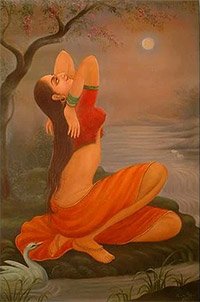
Kamashastra (कामशास्त्र, kāmaśāstra) deals with ancient Indian science of love-making, passion, emotions and other related topics dealing with the pleasures of the senses.
Gitashastra (science of music)
Source: Shodhganga: Elements of Art and Architecture in the Trtiyakhanda of the Visnudharmottarapurana (gita)Vīṇā (वीणा) is the name of a musical instrument classified as Tata (“those instruments which have strings”) which represents one of the four kinds of Instrumental Music, produced by an instrument (ātodya), according to the Viṣṇudharmottarapurāṇa, an ancient Sanskrit text which (being encyclopedic in nature) deals with a variety of cultural topics such as arts, architecture, music, grammar and astronomy.—According to the Saṃgītaratnākara, vīṇā is of two kinds viz., śrutivīṇā and svaravīṇā.
Gitashastra (गीतशास्त्र, gītaśāstra) refers to the ancient Indian science of Music (gita or samgita), which is traditionally divided in Vocal music, Instrumental music and Dance (under the jurisdiction of music). The different elements and technical terms are explained in a wide range of (often Sanskrit) literature.
General definition (in Hinduism)
Source: Google Books: Sonic Theology: Hinduism and Sacred SoundVīṇā (वीणा).—Besides the singing or chanting of the Sāma-veda, instrumental music formed part of the Vedic sacrifices as well, the most important insttrument being the vīṇā, or lute, which was often played by the wife of the sacrificer. A recent study of the vīṇā has found it compared to the human body in the Aitareya-āraṇyaka.
In Buddhism
Tibetan Buddhism (Vajrayana or tantric Buddhism)
Source: archive.org: The Indian Buddhist IconographyVīṇā (वीणा) refers to the “violin” and the deification thereof, as commonly depicted in Buddhist Iconography, and mentioned in the 11th-century Niṣpannayogāvalī of Mahāpaṇḍita Abhayākara.—Her Colour is yellow; her Symbol is the vīṇā instrument; she has two arms.
Vīṇā is described in the Niṣpannayogāvalī (vajraḍāka-maṇḍala) as follows:—
Source: academia.edu: The Structure and Meanings of the Heruka Maṇḍala“Vīṇā is yellow in colour. With her two hands she plays on the musical instrument, the vīṇā”.
[All these deities are collectively described as nude, violent in appearance, wearing garlands of skulls and severed heads and dancing in pratyālīḍha. They display the different instruments as their special symbols.]
1) Vīṇā (वीणा) refers to a “lute” and represents one of the items held in the right hand of Heruka: one of the main deities of the Herukamaṇḍala described in the 10th century Ḍākārṇava chapter 15. Heruka is positioned in the Lotus (padma) at the center; He is the origin of all heroes; He has 17 faces (with three eyes on each) and 76 arms [holding, for example, vīṇā]; He is half black and half green in color; He is dancing on a flaming sun placed on Bhairava and Kālarātrī.
2) Vīṇā (वीणा) is the name of a Ḍākinī who, together with the Vīra (hero) named Vīṇaka forms one of the 36 pairs situated in the Ākāśacakra, according to the same work. Accordingly, the ākāśacakra refers to one of the three divisions of the dharma-puṭa (‘dharma layer’), situated in the Herukamaṇḍala. The 36 pairs of Ḍākinīs [viz., Vīṇā] and Vīras are dark blue in color; they each have one face and four arms; they hold a skull bowl, a skull staff, a small drum, and a knife. Alternatively, the Ḍākinīs have their own marks and motions according to the taste instead of a small drum and a skull staff.
Source: OSU Press: Cakrasamvara SamadhiVīṇā (वीणा) refers to the “(vajra) lute” [i.e., oṃ vajravīṇe hūṃ], according to the Guru Mandala Worship (maṇḍalārcana) ritual often performed in combination with the Cakrasaṃvara Samādhi, which refers to the primary pūjā and sādhanā practice of Newah Mahāyāna-Vajrayāna Buddhists in Nepal.

Tibetan Buddhism includes schools such as Nyingma, Kadampa, Kagyu and Gelug. Their primary canon of literature is divided in two broad categories: The Kangyur, which consists of Buddha’s words, and the Tengyur, which includes commentaries from various sources. Esotericism and tantra techniques (vajrayāna) are collected indepently.
In Jainism
General definition (in Jainism)
Source: archive.org: TrisastisalakapurusacaritraVīṇā (वीणा) refers to “eleven kinds of lutes”, according to chapter 1.6 [ādīśvara-caritra] of Hemacandra’s 11th century Triṣaṣṭiśalākāpuruṣacaritra: an ancient Sanskrit epic poem narrating the history and legends of sixty-three illustrious persons in Jainism.—(cf. Saṅgītaratnākara 6. 9-10, Vol. II, p. 480, and Saṅgītamakaranda, Int. p. VII).
Accordingly, “[...] Sometimes, like Śakra, the King (i.e., Bharata) occupied the court of the amusement-hall to have a concert performed. The best flute-players blew the sweet-sounding flute, which has the first place in concert-work, like the oṅkāra among charms. The lute-players played the eleven kinds of lutes with vyañjana-dhātus, puṣpa, etc., distinct and pleasing to the ear. Likewise the stage-directors made tāla, the mother of dancing and gestures, beautiful with various changes, suitable for poetry [...]”.

Jainism is an Indian religion of Dharma whose doctrine revolves around harmlessness (ahimsa) towards every living being. The two major branches (Digambara and Svetambara) of Jainism stimulate self-control (or, shramana, ‘self-reliance’) and spiritual development through a path of peace for the soul to progess to the ultimate goal.
India history and geography
Source: Cologne Digital Sanskrit Dictionaries: Indian Epigraphical GlossaryVīṇā.—(ASLV), a musical instrument. Cf. vīṇai-kkāṇi (SITI), right of playing on the vīṇā before the god in a temple during worship. Note: vīṇā is defined in the “Indian epigraphical glossary” as it can be found on ancient inscriptions commonly written in Sanskrit, Prakrit or Dravidian languages.

The history of India traces the identification of countries, villages, towns and other regions of India, as well as mythology, zoology, royal dynasties, rulers, tribes, local festivities and traditions and regional languages. Ancient India enjoyed religious freedom and encourages the path of Dharma, a concept common to Buddhism, Hinduism, and Jainism.
Biology (plants and animals)
Source: Google Books: CRC World Dictionary (Regional names)Vina in Chile is the name of a plant defined with Vitis vinifera in various botanical sources. This page contains potential references in Ayurveda, modern medicine, and other folk traditions or local practices It has the synonym Cissus vinifera (L.) Kuntze (among others).
Example references for further research on medicinal uses or toxicity (see latin names for full list):
· Acta Biologica Cracoviensia, Series Botanica (1986)
· Arbust. Amer. (1785)
· Um die Erde (1881)
· Reports from the Botanical Institute, University of Aarhus (1987)
· Listados Florísticos de México (1986)
· Fl. Libya (1980)
If you are looking for specific details regarding Vina, for example health benefits, side effects, diet and recipes, pregnancy safety, extract dosage, chemical composition, have a look at these references.

This sections includes definitions from the five kingdoms of living things: Animals, Plants, Fungi, Protists and Monera. It will include both the official binomial nomenclature (scientific names usually in Latin) as well as regional spellings and variants.
Languages of India and abroad
Pali-English dictionary
Source: BuddhaSasana: Concise Pali-English Dictionaryvinā : (ind.) without
-- or --
vīṇā : (f.) a lute.
Source: Sutta: The Pali Text Society's Pali-English DictionaryVinā, (indecl.) (Vedic vinā=vi-nā (i.e. “not so”), of pron. base Idg. *no (cp. nānā “so & so”), as in Sk. ca-na, Lat. ego-ne, pō-ne behind, etc. See na1) without, used as prep. (or post-position) with (usually) Instr. e.g. Vin. II, 132 (vinā daṇḍena without a support); PvA. 152 (purisehi vinā without men); or Abl. e.g. Sn. 589 (ñāti saṅghā vinā hoti is separated from his relatives; cp. BSk. vinābhavati MVastu I. 243); or Acc. e.g. Mhvs 3, 10 (na sakkā hi taṃ vinā). In compn vinā-bhāva separation (cp. BSk. vinābhāva MVastu II. 141) Sn. 588, 805; Nd1 122; J. III, 95; IV, 155; V, 180; VI, 482 (=viyoga C.). (Page 624)
— or —
Vīṇā, (f.) (cp. Vedic vīṇā) the Indian lute, mandoline S. I, 122=Sn. 449 (kacchā bhassati “let the lyre slide down from hollow of his arm” K. S. I. 153); Th. 1, 467; S. IV, 196 (six parts); A. III, 375; J. III, 91; V, 196, 281 (named Kokanada “wolf’s howl”); VI, 465=580; Vv 6419; 8110; Miln. 53 (all its var. parts); VvA. 138, 161, 210; PvA. 151.—vīṇaṃ vādeti to play the lute Mhvs 31, 82; ThA. 203.

Pali is the language of the Tipiṭaka, which is the sacred canon of Theravāda Buddhism and contains much of the Buddha’s speech. Closeley related to Sanskrit, both languages are used interchangeably between religions.
Marathi-English dictionary
Source: DDSA: The Molesworth Marathi and English Dictionaryviṇā (विणा).—m (Properly vīṇā q.v.) The Win̤a or Indian lute.
--- OR ---
viṇā (विणा).—prep (Properly vinā q.v.) Without: also except.
--- OR ---
vinā (विना).—prep (S) Without. vinākāraṇa Without cause or reason; vinādhāra Without foundation or support; vināparādha Without offence or fault. 2 Except. pōṭāvinā-viṇā-vīṇa-vāñcūna or annāvinā-&c. To employ or use without boarding or feeding (a servant, a beast); vastrāvinā &c. (...without clothing).
--- OR ---
vīṇa (वीण).—f (viṇēṃ) Littering: also the birth, brood, or litter. 2 The season or regular period of bringing forth.
--- OR ---
vīṇa (वीण).—f ī ē (viṇaṇēṃ) Texture, weftage, any particular texture, with respect whether to the manner of weaving, or to the quality or the form of the web.
--- OR ---
vīṇa (वीण).—prep (vinā S) Without: also except. See vinā.
--- OR ---
vīṇā (वीणा).—f (S) The Win̤a or Indian lute. It is a fretted instrument of the guitar kind, usually having seven wires or strings, and a large gourd at each end of the finger-board. There are many varieties.
Source: DDSA: The Aryabhusan school dictionary, Marathi-Englishvinā (विना).—prep Without. vinākāraṇa Without cause.
--- OR ---
vīṇa (वीण).—f Littering. The birth. Texture. prep Without.
--- OR ---
vīṇā (वीणा).—f The Indian lute.
Marathi is an Indo-European language having over 70 million native speakers people in (predominantly) Maharashtra India. Marathi, like many other Indo-Aryan languages, evolved from early forms of Prakrit, which itself is a subset of Sanskrit, one of the most ancient languages of the world.
Sanskrit dictionary
Source: DDSA: The practical Sanskrit-English dictionaryVina (विन).—1 P. To bend oneself, stoop, be bent; विनमन्ति चास्य तरवः प्रचये (vinamanti cāsya taravaḥ pracaye) Kirātārjunīya 6.34; Bhartṛhari 1.67; Bhaṭṭikāvya 7.52. -Caus.
1) To bend (a bow).
2) (In gram.) To change into a cerebral letter.
Derivable forms: vinam (विनम्).
--- OR ---
Vinā (विना).—ind.
1) Without, except (with acc., instr. or abl.); यथा तानं विना रागो यथा मानं विना नृपः । यथा दानं विना हस्ती तथा ज्ञानं विना यतिः (yathā tānaṃ vinā rāgo yathā mānaṃ vinā nṛpaḥ | yathā dānaṃ vinā hastī tathā jñānaṃ vinā yatiḥ) Bv.1.119; पङ्कैर्विना सरो भाति सदः खलजनैर्विना कटुवर्णैर्विना काव्यं मानसं विषयैर्विना (paṅkairvinā saro bhāti sadaḥ khalajanairvinā kaṭuvarṇairvinā kāvyaṃ mānasaṃ viṣayairvinā) 1.116; विना वाहनहस्तिभ्यः क्रियतां सर्वमोक्षः (vinā vāhanahastibhyaḥ kriyatāṃ sarvamokṣaḥ) Mu. 7; Śiśupālavadha 2.9. (vinākṛ means 'to leave, abandon, bereave, deprive of'; madanena vinākṛtā ratiḥ Kumārasambhava 4.21 'bereft of Cupid').
2) In the absence of; विना वचनेन अन्त्यलोप एव न्याय्यः (vinā vacanena antyalopa eva nyāyyaḥ) ŚB. on MS. 1.5.6.
--- OR ---
Vīṇā (वीणा).—
1) The (Indian) lute; मूकीभूतायां वीणायाम् (mūkībhūtāyāṃ vīṇāyām) K.; उत्सङ्गे वा मलिनवसने सौम्य निक्षिप्य वीणाम् (utsaṅge vā malinavasane saumya nikṣipya vīṇām) Meghadūta 88.
2) Lightning.
3) A particular configuration of stars.
Source: Cologne Digital Sanskrit Dictionaries: Shabda-Sagara Sanskrit-English DictionaryVinā (विना).—Ind. Without, except. E. vi privative, nā aff.
--- OR ---
Vīṇā (वीणा).—f.
(-ṇā) 1. The Vina, or Indian lute, a fretted instrument of the guitar kind, usually having seven wires or strings, and a large gourd at each end of the finger board; the extent of the instrument is two octaves: it is supposed to be the invention of Narada, the son of Brahma, and has many varieties, enumerated according to the number of strings, &c. 2. Lightning. E. vī to go, &c., Unadi aff. na, form irr.; or aj-nak vībhāvaḥ pṛṣo0 ṇatvam .
Source: Cologne Digital Sanskrit Dictionaries: Benfey Sanskrit-English DictionaryVinā (विना).— (from vi), prep. Without, [Pañcatantra] i. [distich] 131; except (with acc., instr., and abl.), [Vikramorvaśī, (ed. Bollensen.)] [distich] 10; [Hitopadeśa] pr. [distich] 32, M.M.; [Pañcatantra] 250, 5; iii. [distich] 34 (na yānaṃ vinā pra śasyate, Nothing but, i. e. only, marching is recommended).
--- OR ---
Vīṇā (वीणा).—f. The Indian lute, [Hitopadeśa] ii. [distich] 73.
Source: Cologne Digital Sanskrit Dictionaries: Cappeller Sanskrit-English DictionaryVinā (विना).—[preposition] without, except, beside ([accusative], [instrumental], or [ablative]). vinākṛta separated from, bereft of ([instrumental], abl, or —°); bhūta the same ([instrumental]); kṛtya without.
--- OR ---
Vīṇā (वीणा).—[feminine] lute.
Source: Cologne Digital Sanskrit Dictionaries: Monier-Williams Sanskrit-English Dictionary1) Vinā (विना):—or vinā ind. ([probably] a kind of [instrumental case] of 3. vi) without, except, short or exclusive of (preceded or followed by an [accusative] [instrumental case], rarely [ablative]; cf. [Pāṇini 2-3, 32]; exceptionally ifc.,[gana] e.g. śuci-vinā, without honesty, satya-v, without faith, [Subhāṣitāvali]), [Atharva-veda xx, 136, 13] (not in manuscript), [Manu-smṛti; Mahābhārata] etc. (sometimes vinā is used pleonastically, e.g. natad asti vinā deva yat te virahitaṃ hare, ‘there is nothing, O god Hari, that is without thee’ [Harivaṃśa 14966]).
2) Vīṇā (वीणा):—f. (of doubtful derivation) the Vīṇā or Indian lute (an instrument of the guitar kind, supposed to have been invented by Nārada q.v., usually having seven wires or strings raised upon nineteen frets or supports fixed on a long rounded board, towards the ends of which are two large gourds; its compass is said to be two octaves, but it has many varieties according to the number of strings etc.), [Taittirīya-saṃhitā; Śatapatha-brāhmaṇa] etc. etc.
3) (in [astrology]) a [particular] configuration of the stars (when all planets are situated in 7 houses), [Varāha-mihira’s Bṛhat-saṃhitā]
4) lightning, [cf. Lexicographers, esp. such as amarasiṃha, halāyudha, hemacandra, etc.]
5) Name of a Yoginī, [Catalogue(s)]
6) of a river, [Mahābhārata]
7) Vīnā (वीना):—f. Name of a river, [Monier-Williams’ Sanskrit-English Dictionary] (cf. vīṇā).
Source: Cologne Digital Sanskrit Dictionaries: Yates Sanskrit-English Dictionary1) Vinā (विना):—prep. Without, except.
2) Vīṇā (वीणा):—(ṇā) 1. f. The vīnā or Indian guitar; lightning.
Source: DDSA: Paia-sadda-mahannavo; a comprehensive Prakrit Hindi dictionary (S)Vinā (विना) in the Sanskrit language is related to the Prakrit words: Viṇā, Vīṇā.
[Sanskrit to German]
Sanskrit, also spelled संस्कृतम् (saṃskṛtam), is an ancient language of India commonly seen as the grandmother of the Indo-European language family (even English!). Closely allied with Prakrit and Pali, Sanskrit is more exhaustive in both grammar and terms and has the most extensive collection of literature in the world, greatly surpassing its sister-languages Greek and Latin.
Hindi dictionary
Source: DDSA: A practical Hindi-English dictionary1) Vinā (विना):—(ind) without, in the absence of; —[śarta] unconditional (ly), without any condition.
2) Vīṇā (वीणा):—(nf) a typical Indian lute (with a large gourd at either end); ~[daṃḍa] body of the [vīṇā] between the two end-gourds; ~[pāṇi] an epithet of [sarasvatī]—the goddess of learning; ~[rava] melodious notes of a [vīṇā; ~vādaka] a lute-player, one who plays on a [vīṇā; ~vādana] playing on a [vīṇā; ~vādinī] see ~[pāṇi].
...
Prakrit-English dictionary
Source: DDSA: Paia-sadda-mahannavo; a comprehensive Prakrit Hindi dictionary1) Viṇā (विणा) in the Prakrit language is related to the Sanskrit word: Vinā.
2) Vīṇa (वीण) also relates to the Sanskrit word: Vicāra.
3) Vīṇā (वीणा) also relates to the Sanskrit word: Vīṇā.
Prakrit is an ancient language closely associated with both Pali and Sanskrit. Jain literature is often composed in this language or sub-dialects, such as the Agamas and their commentaries which are written in Ardhamagadhi and Maharashtri Prakrit. The earliest extant texts can be dated to as early as the 4th century BCE although core portions might be older.
Kannada-English dictionary
Source: Alar: Kannada-English corpusVinā (ವಿನಾ):—[independent] = ವಿನಹ [vinaha].
Kannada is a Dravidian language (as opposed to the Indo-European language family) mainly spoken in the southwestern region of India.
Tamil dictionary
Source: DDSA: University of Madras: Tamil LexiconViṉā (வினா) [viṉātal] 5 transitive verb See வினவு-. வினாதல் வினாயவை விடுத்தல் [vinavu-. vinathal vinayavai viduthal] (நன். [nan.] 41).
--- OR ---
Viṉā (வினா) noun < வினா-. [vina-.]
1. Question; கேள்வி. [kelvi.]
2. (Grammar) Question, of five kinds, viz., aṟiyāṉ-viṉā, aiya-viṉā, aṟivoppu-k-kāṇṭal-viṉā, avaṉaṟivu-tāṉ-kāṇṭal-viṉā, mey-y-avaṟkku-k-kāṭṭal-viṉā, according to Tolkāppiyam Iḷampūraṇam: of three kinds, viz., aṟiyāṉ-viṉā, aiya-viṉā, aṟiporuḷ-viṉā, according to Tolkāppiyam Cēṉāvaraiyam: of six kinds, viz., aṟi-viṉā, aṟiyāṉ-viṉā, aiya-viṉā, koḷal-viṉā, koṭai-viṉā, ēval-viṉā, according to Naṉṉūl; அறியான்வினா, ஐயவினா, அறிவொப்புக்காண்டல் வினா, அவனறிவுதான்காண்டல்வினா, மெய்யவற்குக் காட்டல்வினா என ஐவகையாகவும் [ariyanvina, aiyavina, arivoppukkandal vina, avanarivuthankandalvina, meyyavarkug kattalvina ena aivagaiyagavum] (தொல். சொல். [thol. sol.] 13, இளம். [ilam.]) அறியான்வினா, ஐயவினா, அறிபொருள் வினா என மூவகையாகவும் [ariyanvina, aiyavina, ariporul vina ena muvagaiyagavum] (தொல். சொல் [thol. sol], 13, சேனா. [sena.]) அறிவினா,அறியான்வினா,ஐயவினா, கொளல் வினா, கொடைவினா,ஏவல்வினா என அறுவகை யாகவும் [arivina,ariyanvina,aiyavina, kolal vina, kodaivina,evalvina ena aruvagai yagavum] (நன். [nan.] 385, உரை. [urai.]) இலக்கணநூல்களிற் கூறப்படும் கேள்விகள். [ilakkananulkalir kurappadum kelvigal.]
3. Word; சொல். (சூடாமணிநிகண்டு) [sol. (sudamaninigandu)]
4. Sagacity, prudence, discretion; விவேகம். அவனுக்கு வினாப் போதாது. [vivegam. avanukku vinap pothathu.] (W.)
5. Attention; கவனிப்பு. வினாவோடே கேள். [kavanippu. vinavode kel.] (W.)
6. Memory, remembrance; ஞாபகம். அது எனக்கு வினாவில்லை. [gnapagam. athu enakku vinavillai.] (W.)
7. (Arithmetic) A technical term for a part, integral or fractional, of a number; தமிழ்க் கணக்கில் ஒரு தொகையின் பகுதிகளான தனியெண் ணுக்கும் பின்ன வெண்களுக்கு முரிய பெயர். இரண்டேகாலரைக்கால் என்பது இரண்டு, கால், அரைக்கால் என்ற மூன்று வினாக்கள் கொண்டது. [thamizhk kanakkil oru thogaiyin paguthigalana thaniyen nukkum pinna venkalukku muriya peyar. irandegalaraikkal enpathu irandu, kal, araikkal enra munru vinakkal kondathu.] (W.)
--- OR ---
Viṉā (வினா) preposition < vinā. Without, except; அன்றி. தங்களைவினா எனக்கியார் துணை [anri. thangalaivina enakkiyar thunai]?
Tamil is an ancient language of India from the Dravidian family spoken by roughly 250 million people mainly in southern India and Sri Lanka.
See also (Relevant definitions)
Starts with (+456): Vina-etirvinatal, Vina-icaikuri, Vina-mutarcol, Vinaashkari, Vinabha, Vinabhava, Vinabhavam, Vinabhavika, Vinabhavin, Vinabhavya, Vinabhid, Vinabhra, Vinabhu, Vinabhuta, Vinabhutva, Vinabhuya, Vinacam, Vinacan, Vinacanam, Vinaci Vela.
Ends with (+115): Abhidhanapravina, Achovina, Acovina, Adavina, Adyashvina, Agavina, Ai-tokaivina, Aikaberavina, Aiyam-aruttalvina, Aiyavina, Alabuvina, Alavina, Anavina, Anirvina, Anirvvina, Anivina, Anugavina, Apavina, Apravina, Ari-porulvina.
Full-text (+702): Pravina, Vinadanda, Vinavada, Vinam, Vinanubandha, Apavina, Prakvana, Vinokti, Vainika, Kandolavina, Sutravina, Vina-icaikuri, Ramavina, Upavinay, Aiyam-aruttalvina, Vinakkurippu, Vinabhava, Vina-mutarcol, Vinakrita, Vinavalu.
Relevant text
Search found 150 books and stories containing Vina, Vinā, Vīṇā, Vīnā, Viña, Viṉā, Viṇā, Vīṇa, Viṇa, Vinaa, Veena; (plurals include: Vinas, Vinās, Vīṇās, Vīnās, Viñas, Viṉās, Viṇās, Vīṇas, Viṇas, Vinaas, Veenas). You can also click to the full overview containing English textual excerpts. Below are direct links for the most relevant articles:
Garga Samhita (English) (by Danavir Goswami)
Verse 2.24.15 < [Chapter 24 - The Story of Asuri Muni in the Rāsa-dance Pastime]
Verse 5.21.46 < [Chapter 21 - The Story of Śrī Nārada]
Verse 2.24.6 < [Chapter 24 - The Story of Asuri Muni in the Rāsa-dance Pastime]
Rig Veda (translation and commentary) (by H. H. Wilson)
Sahitya-kaumudi by Baladeva Vidyabhushana (by Gaurapada Dāsa)
Text 7.81 < [Chapter 7 - Literary Faults]
Text 9.38 [sword diagram] < [Chapter 9 - Ornaments of Sound]
Text 9.38 < [Chapter 9 - Ornaments of Sound]
Brihad Bhagavatamrita (commentary) (by Śrī Śrīmad Bhaktivedānta Nārāyana Gosvāmī Mahārāja)
Verse 1.7.132 < [Chapter 7 - Pūrṇa (pinnacle of excellent devotees)]
Verse 1.1.60 < [Chapter 1 - Bhauma (the earthly plane)]
Verse 1.2.12 < [Chapter 2 - Divya (the celestial plane)]
Hari-bhakti-kalpa-latikā (by Sarasvati Thkura)
Harshacharita (socio-cultural Study) (by Mrs. Nandita Sarmah)
17. Music, Dance and Musical Instruments < [Chapter 6 - Other Socio-Cultural Aspects]
Related products
